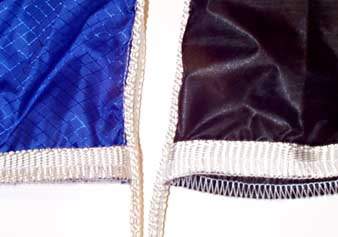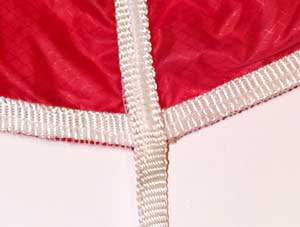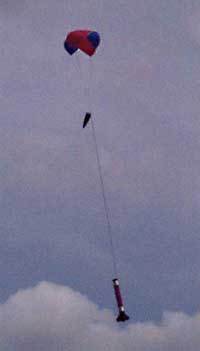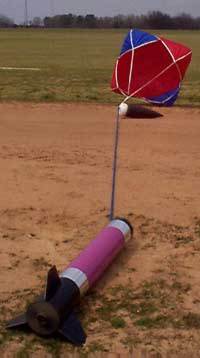| Published: | 2010-11-13 |
| Manufacturer: | Rocketman Enterprises  |

Field testing the ProXP experimental chute!
 "Never worry about another
high speed parachute deployment again!"
"Never worry about another
high speed parachute deployment again!" That's what Ky Michaelson of Rocketman Enterprises says about his new ProXP Experimental Recovery Chutes. And after flying one recently, I tend to believe him.
Ky recently sent me two of his R9C chutes, a regular one and one of the new ProXP series experimental chutes. I was due to attend a regional launch in Perry, Georgia with the rest of the Atlanta-based rocketeers, so I thought it would be a good time to compare the new ProXP chutes to others I had used in the past.
 I have flown Rocketman chutes for years, and have always been
impressed with the quality of Ky's products. I used Rocketman chutes in my
two-stage 2/5 scale Terrier Sandhawk, as well as in the Rocketry Online Project
Scorpion that flew at last year's LDRS. But I was really impressed with the new
line of chutes! They are very heavy duty!
I have flown Rocketman chutes for years, and have always been
impressed with the quality of Ky's products. I used Rocketman chutes in my
two-stage 2/5 scale Terrier Sandhawk, as well as in the Rocketry Online Project
Scorpion that flew at last year's LDRS. But I was really impressed with the new
line of chutes! They are very heavy duty!
The ProXP line of parachutes are made out of ballistic grade 1.9 ripstop nylon with a special coating. This is the same fabric that is used to manufacture hot air balloons. If you compare the fabric to even the standard R9C, you can see the difference right away.
The photo to the left shows the two parachutes side by side. You can see the large diagonal grids the stronger 1.9 ripstop nylon material has in it, as compare the smoother, lighter grade material normally used.
 Another great detail about all of the
Rocketman chutes is that every load bearing joint is heavily reinforced.
Tubular nylon covers every seam in Rocketman chutes, a welcome feature that
makes it hard to strip when combined with the strength of the 1.9 fabric in the
ProXP chute line.
Another great detail about all of the
Rocketman chutes is that every load bearing joint is heavily reinforced.
Tubular nylon covers every seam in Rocketman chutes, a welcome feature that
makes it hard to strip when combined with the strength of the 1.9 fabric in the
ProXP chute line.
The tubular nylon shroud lines are sewn all the way over the top of the canopy for added strength. The photo to the right illustrates how securely the gores are joined together and even the edges are securely lined with the high strength of tubular nylon.
 On the flip side you'll find strong sewn gore joints that are joined
together then joined to the tubular nylon. This is one strong chute! The
tubular nylon terminates into two sewn loops for a non-ending loop of strength.
Rocketman parachutes only have four shroud lines which decreases the chance of
tangling.
On the flip side you'll find strong sewn gore joints that are joined
together then joined to the tubular nylon. This is one strong chute! The
tubular nylon terminates into two sewn loops for a non-ending loop of strength.
Rocketman parachutes only have four shroud lines which decreases the chance of
tangling.
The advertisement running in HPR magazine describes the chutes as having adjustable descent, quick soft deployment and reliable openings.
Well, I wanted to try this new ProXP chute in my LOC/Precision Bruiser, a 7.5" rocket that is pretty good sized, so I proceeded to load up an AeroTech J275W-M reloadable motor.
 Now, simulations state that a standard
Bruiser with a J275W needs a delay of about 7 seconds, and the J275W-S is 6
seconds while the J275W-M is listed at 10 seconds. If my calculations were
right the ProEX chute would deploy 2-3 seconds after apogee, so we would find
out how true the claims were!
Now, simulations state that a standard
Bruiser with a J275W needs a delay of about 7 seconds, and the J275W-S is 6
seconds while the J275W-M is listed at 10 seconds. If my calculations were
right the ProEX chute would deploy 2-3 seconds after apogee, so we would find
out how true the claims were!
The Bruiser was loaded onto the pad, and igniter connected, while the LCO was preparing to give the countdown. Due to a 10-15 MPH wind, the rod was aimed away from the crowd. Initial simulations called for a little over 1500 feet above ground level for peak apogee. I was using motor ejection, there were no electronics on board.
Once skies were confirmed clear, the LCO proceeded to give the countdown. On "0", the big rocket took to the skies with a loud rush of white noise, and after apogee it turn earth-ward. I heard someone say, "Hmmm, may be coming in ballistic." I slowly grinned.
About 1000 feet, the deployment charge went off and the rocket was pointed straight down. The ProXP chute came out, then s-l-o-w-l-y deployed, just as advertised and began to gently lower the rocket to the ground. There was no oscillation, no spinning, just a lazy drift back to the rangehead.
 Now, if the rocket survived that deployment and also the chute, I
would be impressed. The rocket landed practically on the road. And when I say
on the road, I mean "on-the-road," as evidenced in the photo to the
left.
Now, if the rocket survived that deployment and also the chute, I
would be impressed. The rocket landed practically on the road. And when I say
on the road, I mean "on-the-road," as evidenced in the photo to the
left.
You can see as well as I can, the rocket is completely intact, there was no damage to the airframe whatsoever and the ProXP chute was as perfect as if it were still in the bag. I was now totally impressed. It met and surpassed all expectations. I mean, I expected a small zipper after a deployment like it had, but the soft deployment feature really lived up to its name.
From what Ky announced earlier this week, Rocketman parachutes are now offered in three different fabrics; their standard line, the ProXP experimental line and a new ballistic line.
Ky told me, "Our ballistic chute is the strongest chute ever offered to the rocket community. We are so sure that it will never fail that we offer a guarantee that no one would ever dare. If you destroy a Rocketman ballistic chute and your rocket is destroyed because of the failure we will give you $1,000 plus pay for your rocket if there are no signs of heat on the parachute, canopy or shroud lines." Now, THAT is a strong guarantee!
Rocketman Enterprises, Inc. has just finished it's new 1999 Product catalog, which includes all their recovery products. The catalog includes 17 high power rockets from Level 1 to Level 3 as well as new kits, which include the Rocketman 'Rocket Boy'. This rocket is 84" tall - 4" diameter and has a large spun aluminum nozzle. This is one cool looking rocket!
For more information on the Rocketman ProXP series of chutes, or to order the new Rocketman catalog, visit their website at http://www.the-rocketman.com or call 1-800-732-4883.
Written and submitted by
Darrell D. Mobley for Rocketry Online -- Copyright
1996-1999
 |
 |
 |
 |
J.S.S. (December 3, 2007)